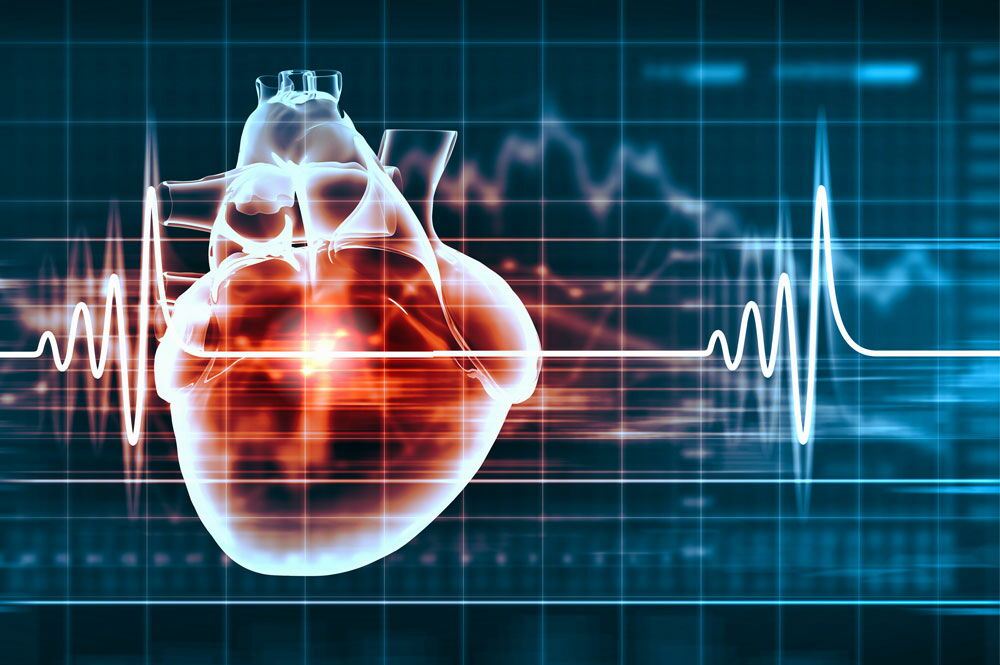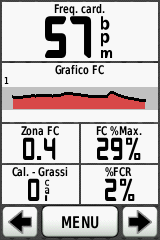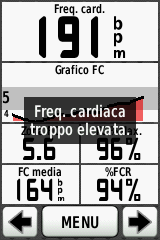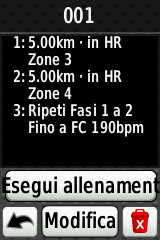The heart rate is the number of heartbeats detected in a given period of time. In its most common use, the 'rate' refers to the number of beats per minute, and the unit of measurement used is indicated by the abbreviation 'bpm'(which is' beat-per-minute', or simply beats per minute). As HR is a precise indicator of how our heart and body are working, knowing, measuring and evaluating the heart rate is also a good practice for optimising sports training.
Maximum heart rate and HR at rest
The heart rate (abbreviated to: HR) of every individual also varies significantly throughout the day. However, there are minimum-maximum limits within which HR may vary; the extremes are generally evaluated by considering two significant values: the resting HR and the maximum HR.

The resting HR is identified at the time you are most relaxed, and to practice this, its common to measure it in the morning, just after you wake up and possibly after you've been sitting up for a few minutes (and are still in a calm, relaxed state). Under these conditions, you measure your heart beats for example, by applying a minimum finger pressure on the wrist or throat (on the carotids), using a clock (or a stopwatch) and counting the number of beats in one minute. For greater accuracy, its advisable to repeat this measurement on several days, note down the values you've measured, and then take the average. What you ultimately obtain is your HR at rest, or 'resting HR'. The resting heart rate is generally higher in children (very high in infants) and decreases proportionally as age increases (excluding, of course, cases of cardiovascular disease or dysfunctions). In an adult, the values are usually in the range of 60-85 bpm.
The Maximum HR (abbreviated to HRMax) is the maximum heart rate that can be tolerated by our body. The calculation in this case is more difficult in comparison to the resting HR; the value of this parameter is evaluated using specific stress tests performed with the support of specialist doctors. For simplicity, some academics have developed formulas that take age into account, and therefore indicate values that are good for the average person. The most well-known method is the Cooper formula, which calculates the maximum HR as:
HRMax (1) = 220 - age
Another formula that appears more precise was discovered by a Japanese academic (H. Tanaka):
HRMax (2) = 208 - 0.7 * age
By comparing the two formulas, we can deduce the following data:
age 20 years HRMax (1) = 200 HRMax (2) = 194
age 30 years HRMax (1) = 190 HRMax (2) = 187
age 40 years HRMax (1) = 180 HRMax (2) = 180
age 50 years HRMax (1) = 170 HRMax (2) = 173
As you can see, Tanaka's formula is slightly lower for younger people and higher above 40, with a difference between younger and older that is more accentuated than with the Cooper formula.
However, these formulas give a general idea about your own HRMax values.
For an athlete, without performing a medical test, it may be useful to use a heart rate monitor and monitor the HR while doing strenuous exercise; the maximum value can increase by about 5% (hardly achieving your HRMax in sports activity, even with inhuman effort...) to get your HRMax value.
In fact, HRMax varies considerably from person to person, as it also depends on lifestyle, sporting activity (intermittent or regular ...) and many other factors (nutrition, environmental factors, congenital predispositions, etc.).
For example, my own personal case is as follows: 40-year-old man, normal physiology, always fond of mountaineering, mountain biking, sports endurance; using a heart rate monitor I have often measured an HR above 190 bpm, for example when I'm putting major effort into mountain biking. The value clearly doesn't respect the previously described formulas, according to which I should have an HRMax of around 180 bpm! My personal calculation led me to consider an HRMax of between 195 and 200 bpm (despite being 40 years of age), and by using this value, I actually calculated the training bands for HR (which you can see below) which are correct ( in my sports practice and according to my personal feelings), so the use of a heart rate monitor is definitely an excellent method for calculating your HRMax fairly accurately.
Heart rate detected with a heart rate monitor,
the first one at rest, the second during a challenging athletic effort


Aerobic and anaerobic phases
Any person's heart rate increases when they are practising a sport or performing activities that involve physical effort.

HR can give us an indication of how well our body and muscles are working. To analyse the matter a little better, we need a brief discussion about the metabolism of the human body. Its well known that in order to move, and also just to breathe and run its internal organs, our bodies burn 'fuel' to produce the energy that moves our muscles. Specifically (and here we refer to a few scientific facts from biology and chemistry, without too much detail), our musculo-skeletal system can make use of three energy production systems, called energetic-systems (which have the job of producing the fundamental energy molecule, called ATP-adenosine triphosphate, which enables movement and muscular effort).
The three energetic systems are as follows:
- The aerobic system: our body uses oxygen to oxidise (practically: burn) lipids (fat) and carbohydrates; there is a further differentiation between a lipidic aerobic system, in which mainly lipids are burnt and which is active at rest or under effort, and a carbohydrate aerobic system, in which carbohydrates (glucose/glycogen) are burnt for more intense efforts .
The passage from 'lipidic' to 'carbohydrate' is called the 'crossover', and some identify this as the 'aerobic threshold' (not to be confused with the 'anaerobic threshold'), which we'll talk about later.
We won't be going into the details of these systems, but underline that our bodies work optimally in the aerobic phase, which allows even prolonged exercise without any harmful consequences like lactic acid accumulation; on the latter point, you should bear in mind that even during this 'aerobic' stage, our bodies still produce lactic acid, but do so in a way that disposes of it, which prevents its accumulation in the muscles. - The anaerobic alactic acid system: for a particularly high effort, the energy produced by the aerobic system is insufficient, and our body puts a process into action that produces energy without the intervention of oxygen (for which we use the term anaerobic), by accessing the energy substrates in the muscles (consuming the phospho-creatine present in them); a huge amount of energy and a great deal of power is provided, but for short periods of time, for exercises that requires maximum power for short times (shot-putting, jumping, sprints, throwing and weight lifting, ..); this system cannot function for more than a few seconds (5 to 15 second max), then the body has to rebuild its phosphate/phosphocreatine reserves; lactic acid is not produced.
- The anaerobic lactic acid system: for intense efforts that exceed the limit allowed by the aerobic system and last longer than the moment the power is delivered by the underlying anaerobic system, our body begins to 'burn' carbohydrates without using oxygen (hence the name anaerobic), but produces an excessive amount of lactic acid in the process, which accumulates in the muscles and leads to fatigue, until it finally inhibits the action of the muscle.
The Anaerobic Threshold
When we're with other athletes, we normally talk about the 'aerobic phase' and the 'anaerobic phase', meaning by the aerobic phase the situations in which the 'aerobic system' and 'anaerobic lactic acid' systems are in operation. The moment of passing from one stage to the other is called the 'anaerobic threshold', which corresponds to the maximum sustained effort our body can make before entering the anaerobic metabolic phase.
In resistance sports, it is essential that the athlete remains in the aerobic phase to perform long-lasting muscular efforts without entering the stage in which excessive amounts of lactic acid are produced (and hence of heavily muscular fatigue), which leads to failures in performance.
The Heart Rate is a sign of how our body is functioning, and it can in particular, indicate which 'phase' our 'engine' is running in: the aerobic phase, or the anaerobic phase. You can calculate an HR value that correlates to the 'anaerobic threshold'; it has been shown that the HR value that corresponds to the anaerobic threshold can be deduced from the HRmax, as a percentage: normally the anaerobic threshold you reach for HR values that are circa 85% -90% of the HRmax.
To have a scientifically accurate measurement of your anaerobic threshold, some method is needed, which requires specialised equipment and medical support. The anaerobic threshold corresponds to a lactate production that reaches a precise concentration limit in the blood, estimated in recent studies to be 4 mmol/L (four millimoles per litre), with slight differences from person to person. By measuring the concentration of lactate during exercise in a medical laboratory, it is possible to detect the HR at the point you this limit is reached.
In addition to the 'anaerobic' threshold, another characteristic that distinguishes our body has been defined by the term 'aerobic threshold': this indicates the situation in which our body begins to produce lactate/lactic acid above the normal levels, and thus enters an aerobic phase with greater exercise (metabolism mainly burns off carbohydrates, glycogen/glucose) but remains below the anaerobic threshold. In practice, our body normally runs on aerobic metabolism, which produces low and constant amounts of lactate, which are easily disposed of, and remains at this stage by making little effort; by increasing the physical activity and heart rate, a point is reached where lactate production (and the concentration of it detected in the blood) increases instead, exceeds the constant baseline amount, and enters a phase in which the concentration varies, going up or down in relation to the physical strain on the muscles. This threshold has been assessed using methods similar to those previously described for the anaerobic threshold, and has been found to coincide approximately with blood lactate values of about 2 mmol/L. The aerobic threshold is a good indicator for those who take part in endurance sports: remaining around the aerobic threshold allows you to express the best performance from your body over prolonged periods. Knowing your heart rate at the aerobic threshold is therefore very useful for regulating physical engagement in endurance activities like marathons, long-distance cycling, cross country skiing etc.
Heart rate and sports training: Heart Rate ZONES
In relation to the specific HRmax of every individual, it has become common practice to identify heart rate ranges that are good indicators for the type of effort and activity we are undertaking, and which are also useful for calibrating our workouts.
These ranges are called 'HR Zones'(or' HR regions 'or' HR areas', where HR indicates Heart Rate, Cardiac Frequency in English).
5 HR zones are usually identified (this method has become common in many heart rate monitors, which are often predisposed to calculating and displaying the 5 HR zones we're now going to describe):
Zone 1 - Our HR is within the range of 50-60% of our HRmax: when the heart reaches this frequency, it means that we are undertaking a motor activity that involves some effort (we are not sitting down on the couch ...) but the effort is mild, and relaxed; at this stage, our body burns a minimum of fat using the aerobic energy system;
Zone 2 - Our HR is in the range of 60% -70% of our HRmax: when the heart reaches this frequency, we are undertaking a motor activity with a clear, but not too tiring effort. Our breathing becomes slightly shallower, but we can still keep a conversation running smoothly; we are in the fully aerobic phase and mainly burning fat, lactic acid production is not exaggerated, so our body can quickly dispose of it and avoid it accumulating.
Zone 3 - our HR is in the range of 70% -80% compared to our HRmax: when the heart reaches this frequency, we are performing a motor activity with a clear, tiring effort, our breathing becomes heavier, and maintaining a conversation is difficult; we are in the aerobic phase with carbohydrate consumption (glycogen, glucose) being prevalent, and the aerobic energy system is in action. Lactic acid production increases but our body is still able to dispose of it properly; at this stage we are training our cardiovascular system and improving our so-called 'aerobic capacity'
Zone 4 - Our HR is in the range 80% 90% compared to our HRmax. When the heart reaches this frequency, we are performing a motor activity with great effort and fatigue, our breathing becomes tense; we are at about the limit of anaerobic threshold, and our body is about to enter anaerobic phase with excessive lactic acid production. Training in this HR zone allows you to raise your anaerobic threshold, train your strength and improve your maximum performance
Zone 5 - our HR is in the range 90% 100% compared to our HRmax. When the heart reaches this frequency, we are performing a motor activity with enormous stress and strain on the cardiovascular system, and our body has entered the anaerobic phase. This condition cannot be sustained for a long time, we are expressing our utmost performance; training with points within Zone 5 leads to improved anaerobic resistance and muscle strength
Based on these definitions, you can, by monitoring your own heart rate, regulate a training session or a sporting competition. Using a heart rate monitor for example, allows you to continuously display your HR value. On today's most popular models, other data is also computed and displayed, including: the current HR zone, the percentage of the current HR compared to HRmax, and some also display a graph with your HR values for the last few minutes. Some advanced heart rate monitors allow you to set 'alarms' that go off if you exceed certain HR limits, enabling you to train (or face races, or just have fun ...) whilst trying to stay within specific HR zones (with the specific consequences and benefits we have described in the definitions for each HR zone).
Example of using a Heart Rate Monitor with HR zone management:


Example of heart rate monitor with beats and HR display.
In this example, the zone detected is 3.9: this indicates we are in zone 3 at the limit of zone 4

Other assessments related to Heart Rate are possible; we've list a few of them here.
Reserve heart rate
This was defined by the physiologist Karvonen as:
Reserve HR = HRmax - HR Rest
The reserve HR can be a highly valuable reference for calculating HRs for training, as it also takes the resting HR into account.
The table of HR percentages we previously described should be applied to reserve HR, with this being identified by the Karvonen formula:
Training HR = (Reserve HR * HR percentage zone) + Resting HR
let's compare this by applying HR zones to HRmax, or by using the latter method:
let's suppose HRmax = 200 HRrest = 50
result HRreserve = 200-50 = 150
In order to train in Zone 3, you need to reach 70%
- applying this to HRmax we get: 0.7 *200 = 140 bpm
- if we use the method with the reserve HR we get: 0.7 * 150+50 = 155 bpm
To train in Zone 4, you have to reach 80%
- if applied to HRmax we get: 0.8*200 = 160 bpm
- if we use the method with the reserve HR we obtain: 0.7*150+50 = 170 bpm
To train in Zone 5, you have to reach 90%
- if applied to HRmax we obtain: 0.9*200 = 180 bpm
- if we use the method with the reserve HR we obtain: 0.7*150+50 = 185 bpm
So, the calculations differ, with the formula that uses reserve HR giving values (heart rates for work outs) greater than those obtained using only the HRmax in calculations; the values obtained using both methods tend to approach each other in the higher HR zones. Many professionals prefer the use of the Cardiac Reserve Rate method to evaluate the intensity of their workouts.
'Training' heart rate
Simply, this means the heart rate in which an aerobic activity is performed which produces improvements in physical fitness.
A generally widespread assessment is that this HR can be considered with values between the Zone 2 and Zone 3 we have previously described, i.e. between 65% and 75%, which are then used for HRmax or to Karvonen's formula (reserve HR*percentage zone HR + resting HR).
'Slimming' heart rate
Evaluating what is the best heart rate or range for weight loss isn't easy, and is often not scientifically proven. It is widely believed that by performing physical activity and staying in HR zone 2 (activity that induces aerobic carbohydrate metabolism) you should burn off more fat. This is true, but recent analyses have shown that calcium loss is also important for losing body fat, and in this case, the greater the physical effort, the more calories you should burn off. Ultimately, it isn't saying that undertaking sports training and checking that you stay in the HR 2 zone is better than training at higher heart rates (increasing the HR and entering HR zones 3 or 4). The ideal solution varies from person to person; the suggestion for any kind of diet and activity that aims at weight loss is to approach qualified nutritionists and trainers and get a customised picture, that takes all of the physiological factors you are subjected to into account.
In conclusion, we've seen how to use information about our personal heart rate and evaluate and regulate it, for a slightly more scientific approach to sports training. Obviously, for a good sports activity (especially at an agonistic level) and to best assess the specific physiological characteristics, it is always best to turn to specialised centres and qualified trainers. You should always remember that even for normal athletic activities, its always better to undergo a preliminary medical examination and obtain a medical picture to ensure you are fit enough for the sporting practice concerned.
